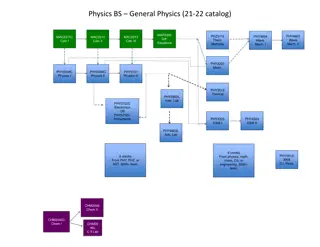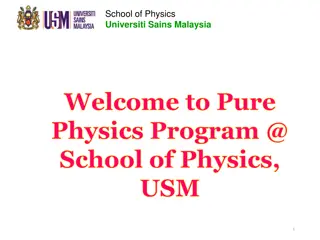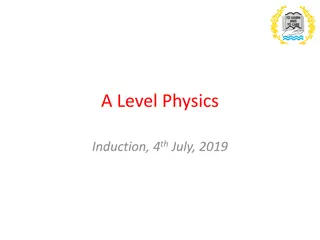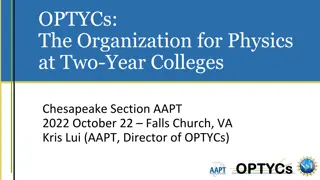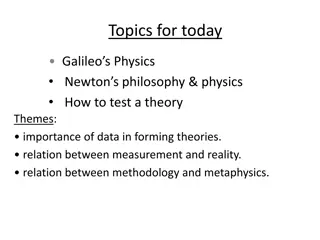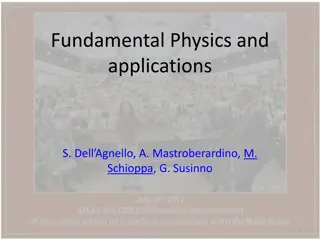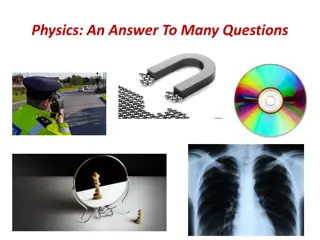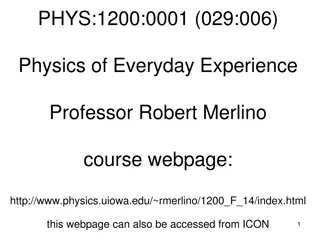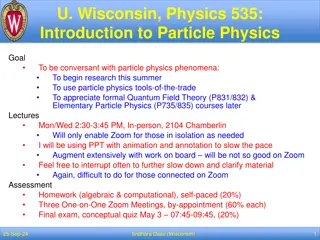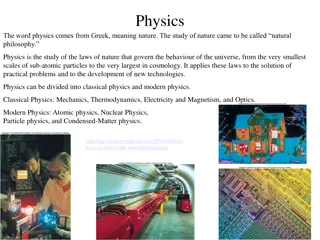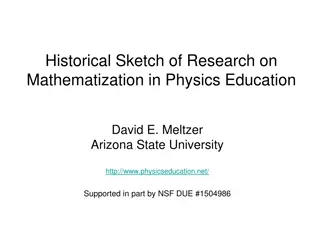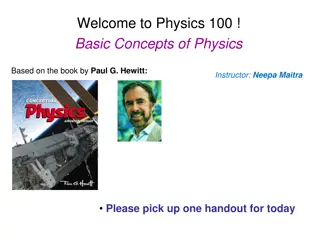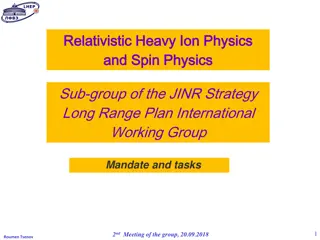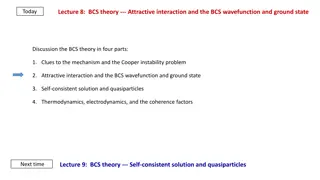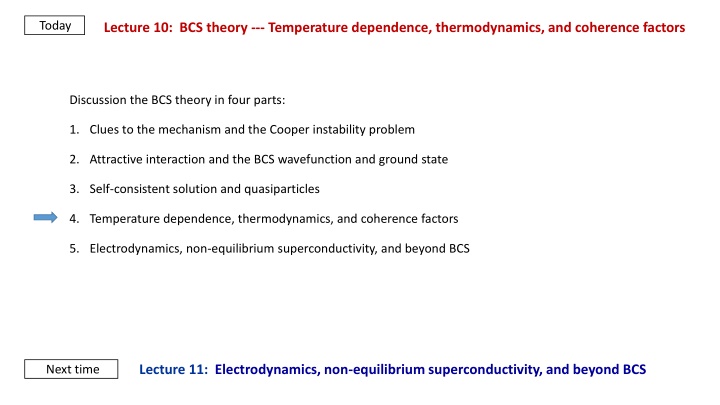
BCS Theory: Temperature Dependence and Excitations
Explore the BCS theory in detail, covering aspects such as temperature dependence, thermodynamics, coherence factors, and excitation phenomena. Learn about the ground state, quasiparticles, and pairing interactions in superconductors and normal metals, along with the impact of finite temperature on energy gaps. Discover how thermal activation influences excitations and the temperature dependence of the energy gap.
Download Presentation

Please find below an Image/Link to download the presentation.
The content on the website is provided AS IS for your information and personal use only. It may not be sold, licensed, or shared on other websites without obtaining consent from the author. If you encounter any issues during the download, it is possible that the publisher has removed the file from their server.
You are allowed to download the files provided on this website for personal or commercial use, subject to the condition that they are used lawfully. All files are the property of their respective owners.
The content on the website is provided AS IS for your information and personal use only. It may not be sold, licensed, or shared on other websites without obtaining consent from the author.
E N D
Presentation Transcript
Today Lecture 10: BCS theory --- Temperature dependence, thermodynamics, and coherence factors Discussion the BCS theory in four parts: 1. Clues to the mechanism and the Cooper instability problem 2. Attractive interaction and the BCS wavefunction and ground state 3. Self-consistent solution and quasiparticles 4. Temperature dependence, thermodynamics, and coherence factors 5. Electrodynamics, non-equilibrium superconductivity, and beyond BCS Lecture 11: Electrodynamics, non-equilibrium superconductivity, and beyond BCS Next time
Last time Introduced the Bogoliubov quasiparticle operators: c c k k k k u v u v = + + + = + + + = + * k v c u 0 0 1 k k k k k + + + + = + * k v c c k c u 1 0 k k k 1 k k k k k Diagonalized the model BCS Hamiltonian: ( ) + + + = + * k * H c c c c c c k k b M k k k k k k k k ( ) + + = + + + * ( ) H E k k b E = + 2 k 2 k E Leading to: 0 0 1 1 M k k k k k k k k k k + + excitations = * 1 V u v ground state 0 0 1 1 k k average + creates a state with ? occupied and ? empty --- all other states are unchanged from the ground state 0 k G + creates a state with ? occupied and ? empty --- all other states are unchanged from the ground state 1 k G
1 1 0.8 0.8 u ( )2 u ( )2 Occupation in ground state 0.6 0.6 v ( )2 v ( )2 0.4 0.4 0.2 0.2 0 0 4 3 2 1 0 1 2 3 4 4 3 2 1 0 1 2 3 4 1 1 0.8 0.8 Pairing interaction 2u ( ) v ( ) 2u ( ) v ( ) 0.6 0.6 0.4 0.4 0.2 0.2 4 3 2 1 0 1 2 3 4 4 3 2 1 0 1 2 3 4 1 1 1 1 0.5 0.5 0.5 0.5 a Effective charge a a 0 a 0 u ( )2 v ( )2 u ( )2 v ( )2 0 0 u ( )2 v ( )2 u ( )2 v ( )2 0.5 0.5 0.5 0.5 3 1 1 4 3 2 1 0 1 2 3 4 1 4 2 1 0 1 2 3 4 1 4 3 2 1 0 1 2 3 4 4 3 2 1 0 1 2 3 4
Excitation picture (T=0) Superconductor (T=0) Normal metal 11 2 2 = 2 k kv k v kf E E k F E 1 GROUND STATE F 1 k K E E F F k + kc+ 0 electron EXCITATIONS k k Quasiparticles do not need to be created in pairs because the ground state charge can change or spin , created in pairs to conserve charge Also c 0 1 k k hole k k k + 1 Q kE Q k E holes k electrons k electrons electron-like qp s e k k k e k 0 holes 0 hole-like qp s = E ( ) = Q e k = = 2 2 = + 2 k 2 k Q u v e e k k k E k k k k k E k k
Finite temperature --- thermal activation of excitations Superconductor Normal metal 1 1 = N = S F F OCCUPATION PROBABLILITY OCCUPATION PROBABILITY k k E k T k k + + 1 e k T 1 e B B S k F k 0.5 0.5 0.4 0.4 = S ( 0) k F = N 0.3 ( 0) k F 0.3 FN 0 T ( , FS 0 T ( , 0.2 ) 0.2 ) 0.1 0.1 0 0 0 0.5 1 1.5 2 0 0.5 1 1.5 2 TT T T Thermally-activated carriers due to energy gap B k T ( ) T Temperature dependence comes from and
Temperature dependence of the energy gap = number operators for QP s + ko ko 1 ( ) + + = = = S F E 0 0 1 1 k k k k k K E k T k + 1 e B Gap equation: 1 2 1 2 E k T k V u v ( ) + + = = 1 2 = 1 V u v F E tanh V u k 0 0 1 1 k k k k E B if otherwise V 0 k V = k c Using BCS form for the attractive interaction: + 2 2 E k T k tanh tanh k 2 k T 2 V V B ( ) T = = B 1 Solve to get 2 2 E + 2 2 k k k k k c k c
( ) T Convert to integral compute numerically 1 ( ) 0 ( ) 0 1/ N V = 2 e ( ) ( ) 0 T c / T T 1 c ( ) T cT occurs when 0 so E n k ( ) tanh / 2 B c k T V = k 1 Gap equation: 2 k k 2 2 e ( ) 0 ( ) 0 = 0.577 Euler s constant 1/ 1/ N V N V = = 1.134 kT e e For weak coupling (? 0 ? 1) c c c ( ) 0 ( ) 0 1/ N V = e c ( ) 0 = 1.764 B c k T
Comparing the electron distribution is the normal and superconducting state 1 1 k T ( ) = ( ) cT = f , f T At Normal metal N e + / N k B c k T e + / 1 1 k B 11 2 ( ) = ,0 f = = + 2 k 2 k 2 k v E Superconductor at T=0 S k k E k 1 0.03 0.02 0.8 ??(?,??) ??(?,??) 0.01 , fN Tc ( ) 0.6 a v ( )2 ???,0 0 , fN Tc ( ) v ( )2 0.4 ???,0 0.01 0.02 0.2 0.03 0 4 3 2 1 0 1 2 3 4 4 3 2 1 0 1 2 3 4 1 ( ) ( ) = S ( ) = ( ) ( ) + ( ) + ( ) = + ( ) 2 2 2 2 2 S S S F 1 f u F v F v u v F In general: k E k T S k k k k k k k k k + 1 e B Electron-state occupation does not change much --- the key to superconductivity is the pair correlations induced by the attractive interaction empty pair state full pair state qp in ? no qp in ?
Thermodynamics Excitations are fermions ?,?? : ?? ??= 2?? ? 1 ?? ? 1 ??+ ?? ??? ??= 2?? ? 1 ??? ? 1 ???+ ??? ? ??? ?? ? ??<??(pairing) ?? 1 1 ???+ 1 ?= ??= ?????+ 1 ?? ? ?? ? ? ?? ? 2?? 2 =2 ??? ??? ??2 1 ??? ?? ??? ?? ?? ? = ??? ? = 2 ?? = 2??? ? ?? 1 ?? ?? ? ? ? variation of gap with ? redistribution of states by ? (NORMAL STATE as 0) (SC STATE)
? ?? 0 ? ?? ? ?? ? ?? Low ? ? ?? : ? constant so 2nd term 0 12 ??? ??? ? ?? exponential behavior ??? Near ??, ? ~1.74 (0) 1 ~ ? 12 1 ? = 1.74 1.76 ???? ?? 12 High ? ?~?? : ? 0 so 1st term = normal state = 3.07 ????1 ? ? ?? 2finite so jump at ? = ?? ?? 2?? ? = 9.42 ? 0 ?? ??? ??? ? 2 (at ??) ? = 2?2 3? 0 ?? ?? 2?? 2??= 6.58? 0 ?? ??= ? ? ? ?? 2 = ? 0 (at ??) = 1.43 ??
Coherence Factors Quasiparticles can scatter, be created (pairbreaking), or be destroyed (recombination) The processes are different from these in normal metals because of: 1. different density of states 2. energy gap 3. Interference terms coherence factors ? ? +??? ?1= ??? ?? ?? ? Consider a perturbation to system: ?? something - on ?? ?? NORMAL STATE ? s are qp operators ?2 matrix elements ? s are qp operators which involve correlations between ?, ? states ?2 modified SC STATE e.g. ? ? ? ? + = ?? ??0++ ?? ?? 1 ?? = ?? ??0+ ?? ??1+ ? ? += ?? ??1+ ???? 0 ? ? = ?? ?? 1 ??1 ?? 0+ ? ?
qp scattering qp creation qp recombination + + + + '1 0 k k '0 0 k k '0 1 k k '1 1 k k ?+? ?? ???? ???? ?? ?? ???? ?+ ? ? ? ???? ?? ?? ???? ???? If we write ?1 in terms of qp operators ?, must add before squaring to get matrix elements: ?1= ?? ?? Two cases: I. Scalar field ?? ?= ? ? ? (EVEN) e.g. electron-phonon interaction, ultrasonic attenuation depends on ? only II. Vector field ?? ?= ? ?? (ODD) e.g. electromagnetic fields ? ? depends on (? ? ) only
Matrix elements : (not transition probability which also depends on ??1 ?? ) For E,E Integrated over For E,E ~ SCATTERING 2 ?? =1 2 ?? 1 2 (???? ???? )2 = 1 21 +?? 0 ?? 21 CASE I 2 ?? =1 2 ?? (???? + ???? )2 = 1 21 +?? 1 2 ?? + 21 + CASE II 1 CREATION/ANNIHILATION 21 ?? 2 ?? 2 ?? 1 2 ?? ??+ ???? 2 = 1 =1 1 CASE I ?? + 21 + 2 ?? =1 2 ?? (?? ?? ???? )2 = 1 21 ?? 1 2 ?? 21 0 CASE II large difference between cases small difference
Examples Type I Ultrasonic attenuation spin qp interaction, electromagnetic absorption Type II Nuclear relaxation diverges broadening (finite lifetimes qp s, unparticles ? 1 4 ? ?? #qp s~ Hebel-Slichter peak ?? ?? ?? 2 2?? 0 = ? 1 + ? ??? ?? ? Great success impossible to explain by two-fluid model or energy gap model coherence vital ?? ~ ?2 ?2 ??1 ?? 2 rate occupation probability
Coherence Factors Physical picture: SUPERCONDUCTING NORMAL Electron correlations cause interference between qp transition probabilities selection rule for transitions depending on symmetry of perturbation ?+? ?? ? ? ? ? ? ? ?? ~ ?2 ?2 ??1 ?? e.g. rapid decay with temperature in ultrasonic attenuation ? destructive interference example: ?? 2 ?? constructive interference e.g. Hebel-Slichter peak in NMR ?


